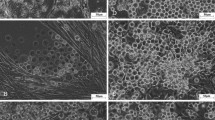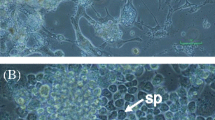Summary
A cell line (IPLB-TpE1) was established from embryos of the hymenopteran parasitoid,Trichogramma pretiosum Riley. Cultures contain a mixture of attached, elongate spindle-shaped cells and large aggregates of suspended cells. Chromosomes of the cells were typical ofTrichogramma species and isozyme characterization showed patterns similar toT. pretiosum adults, but distinctly different fromHeliothis zea, the lepidopteran host from which parasite eggs were obtained. The cells are capable of growth over a wide range of osmotic pressures with equal growth between 350 and 600 mOsm/kg. Optimal growth was obtained with a pH of 6.5. Doubling time at the 40th passage was 72 h and cultures are currently subcultured at weekly intervals.
Similar content being viewed by others
References
Chen, T. R. Microscopic demonstration of mycoplasma contamination in cell cultures and cell culture media. TCA Manual 1:229–232; 1976.
Earley, E. M. Chromosomal preparations from monolayer cell cultures. TCA Manual 1:31–35; 1975.
Eppler, A.; Adam, G.; Sander, E. Nutritional requirements and growth of two cell-lines from the aphid parasiteEphedrus plagiator under different culture conditions. In: Kurstak, E.; Maramorosch, K.; Dübendorfer, A., eds. Invertebrate systems in vitro. Amsterdam: Elsevier North Holland Biomedical Press; 1980:59–66.
Goodwin, R. H.; Adams, J. R. Nutrient factors influencing viral replication in serum-free insect cell line culture. In: Kurstak, E.; Maramorosch, K.; Dübendorfer, A., eds. Invertebrate systems in vitro. Amsterdam: Elsevier/North Holland Biomedical Press; 1980:493–509.
Hink, W. F.; Butz, J. J. Primary culture of ant venom gland cells. In Vitro Cell. Dev. Biol. 21:333–339; 1985.
Hung, A. C. F. Chromosome and isozyme studies inTrichogramma (Hymenoptera: Trichogrammatidae). Proc. Entomol. Soc. Wash. 84:791–796; 1982.
Hung, A. C. F.; Huo, S. Malic enzyme, phosphoglucomutase and phosphoglucose isomerase isozymes inTrichogramma (Hym.: Trichogrammatidae). Entomophaga 30:143–149; 1985.
Jardak, T.; Pintureau, B.; Voegelé, J. Mise en évidence d'un nouvelle espèce deTrichogramma (Hym., Trichogrammatidae). Phénomène d'intersexualité; étude enzymatique. Ann. Soc. Entomol. Fr. (N. S.) 15:635–642; 1979.
Pintureau, B.; Babault, M. Caractérisation enzymatique deTrichogramma evanescens et deT. maidis (Hym., Trichogrammatidae): Etude des hybrides. Entomophaga 26:11; 1981.
Pintureau, B.; Babault, M. Comparaison des enzymes chez 10 souches deTrichogramma (Hym., Trichogrammatidae).Les Trichogrammes. Colloq. INRA (France) No. 9. 1982:31–44,
Pintureau, B.; Goujet, R.; Martouret, D., et al. Etude des estérases chezTrichogramma embryophagum Hartig (Hym., Trichogrammatidae). Choix d'une souche pour lutter contreLaspeyresia pomonella L. (Lep.: Tortricidae) dans la région parisienne. Bull. Soc. Entomol. Mulhouse 1980:17–24.
Sohi, S. S.; Ennis, T. J. Chromosomal characterization of cell lines ofNeodiprion lecontei (Hymenoptera: Diprionidae). Proc. Entomol. Soc. Ontario 1128:45–48; 1981.
Stoltz, D. B.; Vinson, S. B. Viruses and parasitism in insects. Adv. Virus Res. 24:125–171; 1979.
Author information
Authors and Affiliations
Additional information
The mention of a commercial product does not constitute an endorsement by the U. S. Department of Agriculture.
Rights and permissions
About this article
Cite this article
Lynn, D.E., Hung, A.C.F. Development of a continuous cell line from the insect egg parasitoid,Trichogramma pretiosum (Hymenoptera; Trichogrammatidae). In Vitro Cell Dev Biol 22, 440–442 (1986). https://doi.org/10.1007/BF02623443
Received:
Accepted:
Issue Date:
DOI: https://doi.org/10.1007/BF02623443




